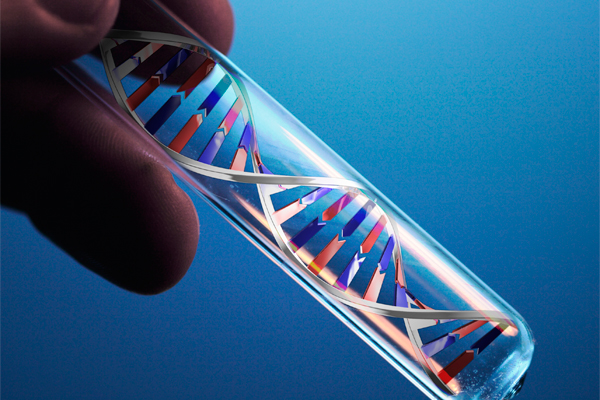Nutrigenomics to redefine nutrition

An emerging discipline, known as nutrigenomics, shows promise of improving animal health and production and developing novel feeding ?strategies. But can we already profit from this new tool? A short review on the current status and future promises of this ‘new’ exciting science.
By Emmy Koeleman
Since the first gene was suggested by Gregor Mendel in the 1860s, scientists have been searching for ways to decode them. Uncovering the secrets locked in each species’ genomes will give researchers information on how genes are linked to milk production of the dairy cow, the ability to fight diseases in poultry and pigs and to understand how obesity can be prevented in cats and dogs and much more. Already dozens of animal, plant and microbe genomes have been sequenced, but only in the last few decades we gained a good understanding of the genomes of our production animals. This opened up a range of new sciences such as nutrigenomics; the science that explores how certain nutrients or bioactive dietary compounds can influence gene expression. This approach has been around for more than a decade, but has really only became a useful practical tool over the last seven or eight years. But how does nutrigenomics work? It is known that feed ingredients affect transcription factors, protein expression and metabolite production and subtle changes in animal diets can ‘turn on’ or ‘turn off’ specific genes responsible for cellular activities and health. This gene regulation in turn impacts the overall health and production of the animal. “Each nutrient, management practice and nutrient interaction regulates metabolic process in their own unique way. Nutrigenomics allows us to see the basic metabolic switches that control this metabolism. By examining specific gene expression patterns it is possible to readily compare the effects of nutrients on metabolic pathways supporting improved performance, disease resistance, immunity and overall wellbeing,” explains Karl Dawson from Alltech. Nutrigenomics can be seen as “fine-tuning” of the metabolism to help the animal to better adapt to or face stressful periods (such as the transition from pregnancy to lactation in dairy cows or pigs that are weaned).
Different tools available
The development of tools and techniques have been crucial in the further development and understanding of nutrigenomics. Knowing the genes is one thing, but to study the effects of metabolites on the genes is a different thing. “The advent of several molecular techniques together with the genome sequencing was essential to study how nutrients effect the genes. Essential for nutrigenomics studies were also the discovery of ligand-dependent nuclear receptors, transcriptional factors able to bind and activate or repress transcription of genes under stimuli of several molecules such as hormones and nutritional molecules.
Those nuclear receptors are the primary target for nutrigenomics studies,” says Massimo Bionaz, researcher of nutrigenomics in dairy cows at the Oregon State University. Nowadays many tools are available, with real time reverse transcriptase-polymerase chain reaction (RT-PCR), microarrays, and RNA sequencing being the most common. Within Alltech, scientists have been working with microarrays and other techniques for many years. “Gene expression patterns are typically evaluated using ‘gene chip’ microarrays. These can allow for the evaluation of the expression of thousands of genes at one time. However, there are many techniques that can be used to look at specific genes and their expression such as real-time PCR assays. Increasingly, microarrays analysis is being replaced by sophisticated nucleic acid sequencing techniques that can more accurately describe variations in gene structure. Additionally, complex analytical systems for measuring protein expressions (proteomics) are now being used to further elucidate the overall effects of nutrition on gene expression,” explains Dawson from Alltech.
Current topics of research
“Although nutrigenomics seem to be taking off in the last few years, it is still mainly used for research and by large companies,” says Kelly Swanson, professor at the University of Illinois. Swanson is one of the researchers that is actively involved in nutrigenomic research for pets. “Our laboratory has been quite active in dog and cat nutrigenomics area over the past 5 to 6 years. Current topics of our research include novel protein, novel carbohydrate, and functional ingredient evaluation, obesity, and gastrointestinal health, all of which are commonly studied using nutrigenomics tools, according to Swanson. Nutrigenomics shows promise for the pet food industry, but its use greatly differs depending on the company. Swanson: “There were a few early adopters in the pet food and ingredient supplier industries, but most have not used it due to expense or lack of trained scientists. I know of a few specific commercial pet diets that were developed, in part, by using nutrigenomics research strategies (e.g. nutrient-induced changes on gene expression). Because the outcomes resulting from such research may be widespread once published, it is difficult to know how many diet formulations may be impacted by this science in some way.”
Potential for dairy
According to Bionaz from Oregon State University, nutrigenomics can disclose us more precisely what micro-ingredients do at gene level. “The nutritional molecules with the strongest potential for nutrigenomics effect are fatty acids, particularly long-chain fatty acids. The nutrigenomics effect of those is quite strong but in the same time quite complex. Few dairy scientists are trying to dissect out the main targets of those fatty acids, especially among the nuclear receptors. Amino acids are also interesting. A recent published paper indicated a strong nutrigenomics effect of methionine and lysine in controlling expression of genes coding for proteins involved in milk protein synthesis,” he says. Bionaz is currently working on the nutrigenomics effects of long-chain fatty acids and especially in the potential of exploiting the capability of the peroxisome proliferator-activated receptors to bind and be activated by fatty acids in lactating cows and has recently concluded a study in lactating goats were the in vivo activation of one of these receptors decreased the somatic cell count in milk, including the animals where a sub-clinical mastitis was induced.
On the contrary, Alltech is focusing its research on the key regulatory roles of minerals on gene expression. Dawson: “These nutrients play key roles in the regulation of the metabolic processes associated with health, performance and product quality. We are also interested in using nutrigenomics to define the effects of nutrition on tissue development in growing animals, tissue repair, immune responses, reproductive performance, mitochondrial function and hormone function.”
Are we on track?
While it is unlikely that the use of microarrays or other nutrigenomic tools will ever become a routine tool for evaluating nutritional response on the farm, measures of gene expression have become a valuable tool for characterising and comparing the specific effects of nutrients and nutritional programmes. This has allowed companies such as Alltech to uncover many hidden effects of nutrition and specific nutrient interactions that can be used to enhance animal health and performance. Dawson: “This has also allowed for the development of many novel strategies for producing higher quality food products while contributing to enhanced food safety. By providing a quick snapshot of nutrient effects, it has dramatically decreased the time needed for the development of innovative feeding strategies. As we learn more about the structure and function of specific genes and regulatory mechanisms, it will become easier to interpret the information coming from gene expression analysis. Bionaz agrees that much work has been done already. “In bovine the genome has been fully sequenced and a lot of work is currently done to fully annotate it. I think, for this species, we are in a very good shape to successfully carry out nutrigenomics studies. But we need more funds to carry out this kind of research in the future. Then we can take the science a step further and to take a more holistic approach (look further than the effect of one nutrient on one or more genes). This is challenging but wouldn’t it be great to have ration software able to account for the nutrigenomics effect of different nutritional molecules in the feed, which is automatically updated by new data from nutrigenomic research?”
No common practice yet
Experts agree that nutrigenomics research is and will continue to benefit the human and animal nutrition industries. “While it is unlikely that daily monitoring of gene profiles in production livestock will ever be a common practice or cost effective, nutrigenomics tools will undoubtedly help us redefine nutritional concepts and provide information that will revolutionise our views of nutrition. These technologies have already proven their value in the development of novel feeding strategies,” according to Dawson from Alltech. Researcher Swanson does not see nutrigenomics being used for day-to-day decisions in the near future. “Other issues, including ingredient price, availability, nutritional quality, safety, etc. are more relevant in that regard. At the same time, the analytical tools, computing power, and bioinformatics programs continue to improve research capabilities and understanding of complex biological systems, including those pertaining to companion and livestock animal nutrition and health,” concludes Swanson.
[Source: AllAboutFeed magazine Vol 30 nr 3, 2014]











